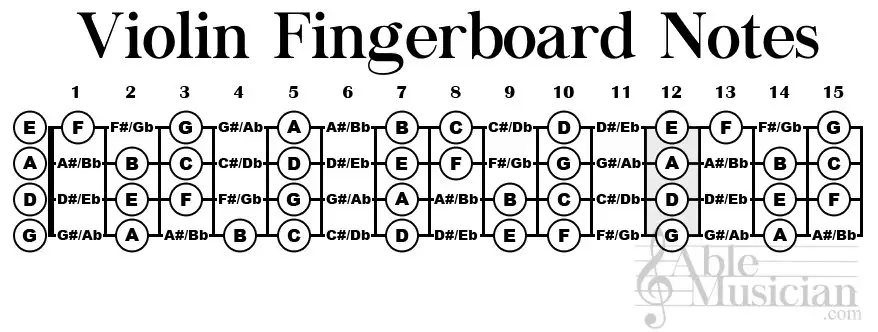Here’s an image showing the notes on the fingerboard of the violin.

The violin strings are tuned to GDAE tuning, and each fingering row up the fingerboard increases the played pitch of that string by a half-step.
At the 12th fingering row, the notes then repeat from GDAE again, as this is an octave higher than the open strings (there are 12 half-steps in an octave).
This fingering row is highlighted in gray on the image.
About the Violin Fingerboard
The fingerboard of a violin is the thin strip of wood that runs along the top of the neck and contains the frets.
It is typically made of ebony, a very hard and dense wood which provides a good surface for the player’s fingers.
The fingerboard is glued to the neck of the violin and is usually cut at an angle to match the angle of the neck.
It has grooves called channels that are cut out to accommodate the strings and guide them to the tailpiece.
The fingerboard also has small raised areas called fret notches that help the player to find the correct position of the fingers.
It plays a crucial role in the violin’s intonation, which is the accuracy of the pitch of the notes played on the instrument.
The fingerboard also helps to keep the strings in place, preventing them from slipping or shifting while playing.
It is also where the player performs techniques such as vibrato and shifting.
Violin Fingerboard Material
The fingerboard of a violin is typically made of a hardwood such as ebony.
Ebony is a dense, hard wood that is well-suited for use on the fingerboard because of its durability and resistance to wear.
It also provides a smooth, non-slip surface for the player’s fingers, and its dark color provides a striking contrast with the lighter-colored wood of the neck and body of the violin.
Other materials that have been used to make violin fingerboards include rosewood, which is a slightly softer and less dense wood than ebony, but still offers good durability and an attractive color.
Some manufacturers use synthetic materials such as carbon fiber for violin fingerboards, these materials are very durable and resistant to changes in humidity and temperature, also they provide a stable playing surface.
The choice of fingerboard material can affect the sound and feel of the violin, with ebony generally considered to provide a brighter, more focused tone, while rosewood and other woods can provide a warmer, more resonant tone.
Fingerboard Positions
On a violin, the fingerboard positions refer to the different places on the fingerboard where the player’s fingers should be placed in order to play notes at different pitches.
The fingerboard of the violin is divided into four sections: the open string, first position, second position and third position.
The open string position refers to playing the notes on the violin without pressing down on any of the fingerboard. It is the natural sound of the string and it is used as a reference point.
First position is the most commonly used position on the violin fingerboard. In this position, the fingers press down on the strings just behind the nut, at the very beginning of the fingerboard.
This position is used to play notes in the lower register of the violin.
Second position is used to play notes in the middle register of the violin. In this position, the fingers press down on the strings slightly further up the fingerboard than in first position, typically between the first and fifth frets.
Third position is used to play notes in the upper register of the violin. In this position, the fingers press down on the strings even further up the fingerboard than in second position, typically between the seventh and tenth frets.
There are also more advanced positions like fourth and fifth positions that are used by more advanced players to access higher notes and to play more challenging music.
It is important to note that the fingerboard positions are not fixed, and players can use different positions to play the same note, depending on the context of the music and the player’s technique and preference.
